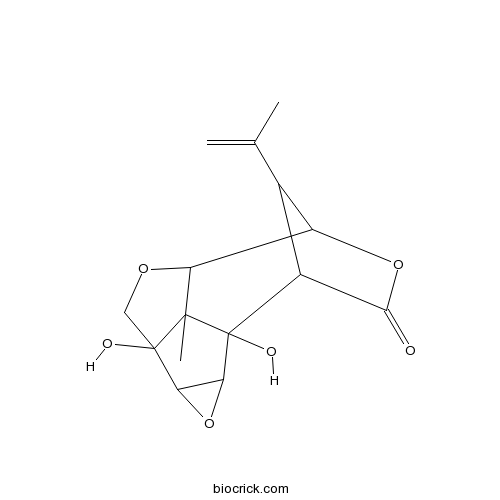CorianinCAS# 35481-77-7 |

Quality Control & MSDS
3D structure
Package In Stock
Number of papers citing our products

| Cas No. | 35481-77-7 | SDF | Download SDF |
| PubChem ID | 169700 | Appearance | Powder |
| Formula | C15H18O6 | M.Wt | 294.3 |
| Type of Compound | Sesquiterpenoids | Storage | Desiccate at -20°C |
| Solubility | Soluble in Chloroform,Dichloromethane,Ethyl Acetate,DMSO,Acetone,etc. | ||
| SMILES | CC(=C)C1C2C3C4(C(CO3)(C5C(C4(C1C(=O)O2)O)O5)O)C | ||
| Standard InChIKey | IKTUZVAVHCTHSU-UHFFFAOYSA-N | ||
| Standard InChI | InChI=1S/C15H18O6/c1-5(2)6-7-12(16)20-8(6)9-13(3)14(17,4-19-9)10-11(21-10)15(7,13)18/h6-11,17-18H,1,4H2,2-3H3 | ||
| General tips | For obtaining a higher solubility , please warm the tube at 37 ℃ and shake it in the ultrasonic bath for a while.Stock solution can be stored below -20℃ for several months. We recommend that you prepare and use the solution on the same day. However, if the test schedule requires, the stock solutions can be prepared in advance, and the stock solution must be sealed and stored below -20℃. In general, the stock solution can be kept for several months. Before use, we recommend that you leave the vial at room temperature for at least an hour before opening it. |
||
| About Packaging | 1. The packaging of the product may be reversed during transportation, cause the high purity compounds to adhere to the neck or cap of the vial.Take the vail out of its packaging and shake gently until the compounds fall to the bottom of the vial. 2. For liquid products, please centrifuge at 500xg to gather the liquid to the bottom of the vial. 3. Try to avoid loss or contamination during the experiment. |
||
| Shipping Condition | Packaging according to customer requirements(5mg, 10mg, 20mg and more). Ship via FedEx, DHL, UPS, EMS or other couriers with RT, or blue ice upon request. | ||
| Description | 1. Corianin and coriatin demonstrate synergistic effect to insecticidal activity of tutin againstarmyworm. |

Corianin Dilution Calculator

Corianin Molarity Calculator
| 1 mg | 5 mg | 10 mg | 20 mg | 25 mg | |
| 1 mM | 3.3979 mL | 16.9895 mL | 33.9789 mL | 67.9579 mL | 84.9473 mL |
| 5 mM | 0.6796 mL | 3.3979 mL | 6.7958 mL | 13.5916 mL | 16.9895 mL |
| 10 mM | 0.3398 mL | 1.6989 mL | 3.3979 mL | 6.7958 mL | 8.4947 mL |
| 50 mM | 0.068 mL | 0.3398 mL | 0.6796 mL | 1.3592 mL | 1.6989 mL |
| 100 mM | 0.034 mL | 0.1699 mL | 0.3398 mL | 0.6796 mL | 0.8495 mL |
| * Note: If you are in the process of experiment, it's necessary to make the dilution ratios of the samples. The dilution data above is only for reference. Normally, it's can get a better solubility within lower of Concentrations. | |||||

Calcutta University

University of Minnesota

University of Maryland School of Medicine

University of Illinois at Chicago

The Ohio State University

University of Zurich

Harvard University

Colorado State University

Auburn University

Yale University

Worcester Polytechnic Institute

Washington State University

Stanford University

University of Leipzig

Universidade da Beira Interior

The Institute of Cancer Research

Heidelberg University

University of Amsterdam

University of Auckland

TsingHua University

The University of Michigan

Miami University

DRURY University

Jilin University

Fudan University

Wuhan University

Sun Yat-sen University

Universite de Paris

Deemed University

Auckland University

The University of Tokyo

Korea University
- Hirsuteine
Catalog No.:BCN2756
CAS No.:35467-43-7
- Caraphenol A
Catalog No.:BCN5295
CAS No.:354553-35-8
- INO-1001
Catalog No.:BCC2212
CAS No.:3544-24-9
- Bendamustine HCl
Catalog No.:BCC1153
CAS No.:3543-75-7
- 5-[Bis(2-hydroxyethyl)amino]-1-methyl-1H-benzimidazole-2-butanoic acid ethyl ester
Catalog No.:BCC8724
CAS No.:3543-74-6
- 1-Methyl-5-amino-1H-benzimidazole-2-butanoic acid ethyl ester
Catalog No.:BCC8469
CAS No.:3543-73-5
- 1-Methyl-5-nitro-1H-benzimidazole-2-butanoic acid ethyl ester
Catalog No.:BCC8470
CAS No.:3543-72-4
- Norathyriol
Catalog No.:BCN5294
CAS No.:3542-72-1
- J 113863
Catalog No.:BCC7422
CAS No.:353791-85-2
- Honokiol
Catalog No.:BCN1001
CAS No.:35354-74-6
- HLM006474
Catalog No.:BCC5403
CAS No.:353519-63-8
- 9-Hydroxycalabaxanthone
Catalog No.:BCN5293
CAS No.:35349-68-9
- SC-514
Catalog No.:BCC4554
CAS No.:354812-17-2
- Balicatib
Catalog No.:BCC5139
CAS No.:354813-19-7
- 3-beta-O-(trans-p-Coumaroyl)maslinic acid
Catalog No.:BCN1452
CAS No.:35482-91-8
- TCS 1205
Catalog No.:BCC7819
CAS No.:355022-97-8
- Ki16198
Catalog No.:BCC4560
CAS No.:355025-13-7
- Ki16425
Catalog No.:BCC1155
CAS No.:355025-24-0
- 6'-O-p-Hydroxybenzoylcatalposide
Catalog No.:BCN5297
CAS No.:355143-38-3
- YM-155 hydrochloride
Catalog No.:BCC2066
CAS No.:355406-09-6
- Buflomedil HCl
Catalog No.:BCC4760
CAS No.:35543-24-9
- N,N-dimethyl-2-Quinoxalinamine
Catalog No.:BCC9066
CAS No.:35552-76-2
- tert-Butyl rosuvastatin
Catalog No.:BCC9163
CAS No.:355806-00-7
- Betmidin
Catalog No.:BCN8253
CAS No.:35589-22-1
Phytochemistry and biology of Loranthus parasiticus Merr, a commonly used herbal medicine.[Pubmed:24467533]
Am J Chin Med. 2014;42(1):23-35.
Loranthus parasiticus Merr (L. parasiticus) is a member of Loranthaceae family and is an important medicinal plant with a long history of Chinese traditional use. L. parasiticus, also known as Sang Ji Sheng (in Chinese), benalu teh (in Malay) and baso-kisei (in Japanese), is a semiparasitic plant, which is mostly distributed in the southern and southwestern regions of China. This review aims to provide a comprehensive overview of the ethnomedicinal use, phytochemistry and pharmacological activity of L. parasiticus and to highlight the needs for further investigation and greater global development of the plant's medicinal properties. To date, pharmacological studies have demonstrated significant biological activities, which support the traditional use of the plant as a neuroprotective, tranquilizing, anticancer, immunomodulatory, antiviral, diuretic and hypotensive agent. In addition, studies have identified antioxidative, antimutagenic, antiviral, antihepatotoxic and antinephrotoxic activity. The key bioactive constituents in L. parasiticus include coriaria lactone comprised of sesquiterpene lactones: coriamyrtin, tutin, Corianin, and coriatin. In addition, two proanthocyanidins, namely, AC trimer and (+)-catechin, have been recently discovered as novel to L. parasiticus. L. parasiticus usefulness as a medicinal plant with current widespread traditional use warrants further research, clinical trials and product development to fully exploit its medicinal value.


